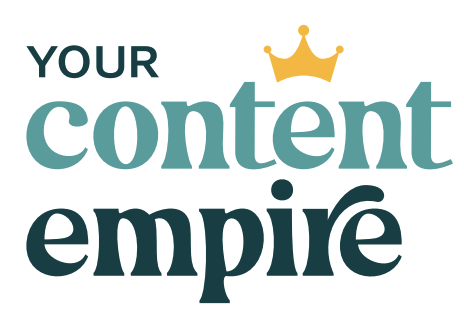Tired of staring at a blank screen, wondering what to post? What if I told you I create 260+ pieces of content every year without breaking a sweat? Today, I'm giving away my entire daily writing system – the exact process I use to never run out of ideas and consistently create content that grows my business. The best part? It only takes 25 minutes a day.
If you've ever felt overwhelmed by content creation or struggled to stay consistent, this video is for you. Let's break down my daily writing system step by step…
Prefer to watch this video?
Want to listen to this on the go?
Meet the Daily Writing System
The daily writing system is an essential practice for thought leaders, content creators and business owners who want to leverage their content to grow an audience.
In its simplest form, it involves choosing a question or idea, writing a piece of content around it and then sharing it. What you write could be a social media post, a blog post, an email or anything else you publish regularly.
For those of you into pro/con lists, the pros are basically endless.
- It's a practice where you get cumulatively better at thinking, expressing your thoughts, writing and publishing
- And while you “practice” you start seeing better and better results right away (growing views, more email sign-ups, more purchases, growing engagement)
- It gives you the chance to refine your ideas, test different things, different messages and angles and see what works and resonates. This lets you turn those single pieces of content into bigger things like digital products, courses, signature talks, webinars, workshops, books
- It also lets you build up a body of work – stick to this practice even just 3 days a week for a year and you'll have 156 pieces of content you can cycle through and reshare
In my opinion, this is the single best content habit you can adopt this year.
What to Write with Your Daily Writing System
I think the most important aspect of your daily writing system is having ideas on what to write about. But having ideas, and good ideas especially, is not so much about “the muse” as it is about creating a habit of ideation.
You probably have hundreds of great ideas every day but the difference between the people who become known for those ideas and those who don't is cultivating a practice of noticing and saving those ideas—and then doing something with them.
Here's a sneak peek at my idea and inspiration system:
I save ideas as I'm working in a bunch of different spots—from a pin on Pinterest, from an email I receive, a link I come across, an Instagram post I have to save or just random things that pop into my head. In the moment, I save these in the most convenient spot. I call these my collection points.
- So on Pinterest, I have a secret board.
- In my inbox, I have a folder for things to revisit.
- On Instagram, I have a save folders for these posts the spark inspiration.
- And for the on-the-go ideas I jot these down in my notes app.
On a regular basis (every Friday afternoon), I go through all these collection points and move the things I'm still inspired by to my inspiration bank (which I host in Airtable).
I also regularly brainstorm on topics I cover. I use my How Factory topic brainstorming, think through angles and opinions I hold that might go against the grain and I make sure these make their way to my inspiration bank too.
So when it comes to my daily writing, I have a plethora of ideas to choose from. And I make sure I've chosen what I'm going to write about next BEFORE I actually sit down and write it too. I don't want to waste any of my creative time figuring out what to write about.
The Daily Writing System – Step-By-Step
Having ideas and doing something with them are 2 completely different things. I've known plenty of people who have great ideas and nothing really to show for them. They're so caught up in chasing any shiny new idea that they never bring any of them to the finish line.
This is where my daily writing process comes into play. So we've already covered HOW you're coming up with ideas and storing them. The next step is to decide what you're writing about before you sit down to write it. I like this as part of my weekly planning and start by answering the question: What are my daily writing topics for the week?
Once I have the idea, I'm ready to write.
I set up a form for my daily writing in Airtable. It has 4 questions:
- What’s the target of this message? (this is the paid offer or free offer that this daily writing is related to)
- What’s the angle for this daily writing? (this is my specific topic I'm writing about)
- What are my initial thoughts on this angle? (I spend at least 10 minutes writing about this using a timer)
- What is the connection between this angle and my offer?
Usually I end up writing an entire email or social media post just within these questions that's pretty much ready to go. But even if it's not 100% good to go, it will be with a few edits.
The form adds this daily writing in my Airtable Content Organization Hub and sends me a copy to my inbox.
Shameless plug here: If you're feeling less than confident about implementing a daily writing system. Borrow mine to help you build up the skill. In my Content Habit App, I set up the prompts and the forms for you. All you gotta do is show up and write one prompt a day and it'll send it to you and track your consistency with your new habit.
How to Use Your Daily Writing
The final piece of a daily writing system is sharing that writing. I find it really helpful to embrace an attitude of, “I'm just testing things” and seeing how the message and angles resonate. This can help me stop any perfectionism in its tracks.
There are 2 different ways that I share my writing.
If I need something to share that day (and I try to share something whether it's in the form of an email, a social media post or a story), I will take my writing, create a simple video, carousel or image and publish it that day. I've pre-determined my publishing pathways and have documented systems for each of these.
Here's an example: If I want something to share on Instagram using my daily writing, I have templates set up for both carousels and reels. The reels just need me to add some b-roll and come up with a hook for the video (basically 1-2 lines as title text on the video that encourages people to read the caption or watch the rest of it). I can then export that video, copy and paste in my caption and voila, ready to publish.
In most cases, I like to work and write way ahead of when I want to share or publish. To do this, I have a weekly processing day. This is when I review all of my daily writing, figure out what I want to share/publish when. Create any images or videos I need OR components for an email like subject/teaser/ps and have all these things ready to go for when I publish on a daily basis or have a VA do the publishing piece for me.
Thinking of my daily writing system as three separate parts – the ideation, the writing and the publishing – helps me follow through more often without getting stuck in the details of publishing when I should be worried about writing or focusing on ideation before I jump to writing.
Ready to set up your daily writing system?
Follow the steps I've outlined in this post:
- Set up a system for capturing your ideas and inspiration so you're never at a loss for what to write about (steal my Airtable Content Organization Hub here which includes my inspiration bank system)
- Next, create a daily practice for writing. Whether you just open up a blank doc, have your topic on hand and are good to go. OR if you want to set up a form to simply answer the questions and have it added to a spreadsheet and email you a copy of the daily writing. I'd also recommend blocking off a pomodoro (25-minute) block in your calendar at the start of your workday for doing your daily writing
- Finally, document your systems for publishing your daily writing. Have image templates ready to. Checklists for each platform ready to follow to get your ideas or posts out there.
If you want to build up your daily writing practice, sign up for the my FREE Content Post-It Challenge:












